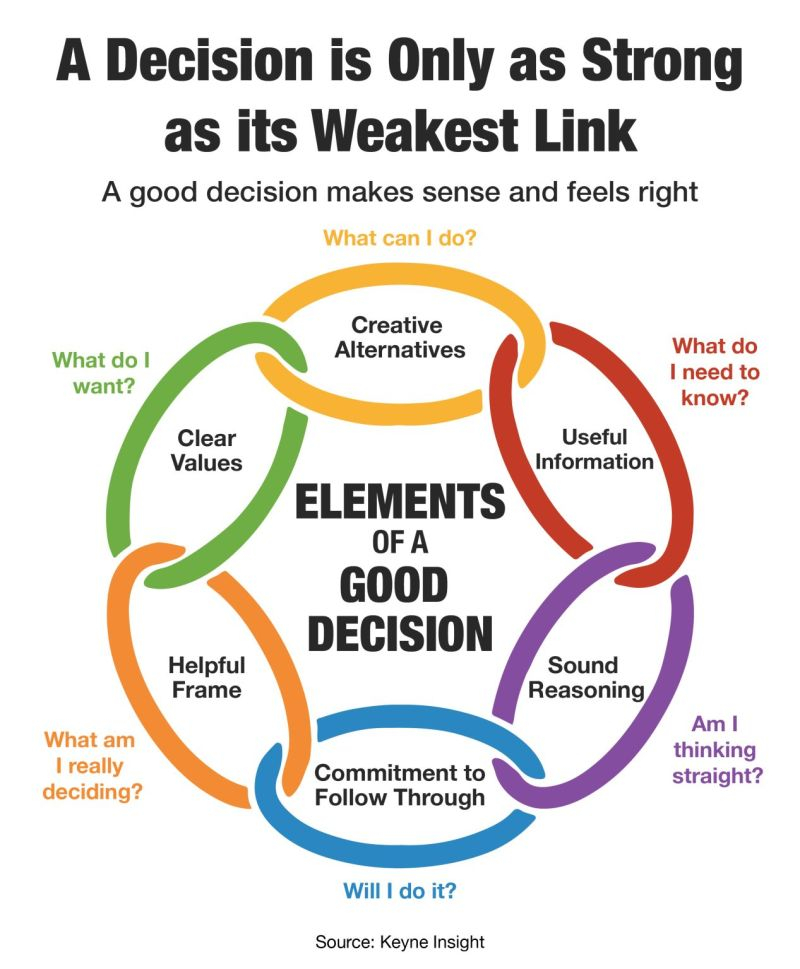"A decision is not an event. It is a process. This means any decision is only as strong as its weakest link. Which of these 6 links is your weakest?
We often think of decisions as events, sudden moments when a choice is made between options or a yes or no is decided. But, that’s not what decisions are really like.
Decisions are processes that unfold over time. There’s preparation, options, evaluations, negotiations, implementation, and so on.
This doesn’t mean people are aware of this process. Often they are not. Also, the process can go very fast, making it seem like an event.
To unravel the complexity of decisions, it is useful to see them as a chain of aspects or questions. These six are critical:
1. Clear Values. What do I want?
2. Create Alternatives: What can I do?
3. Useful Information: What do I need to know?
4. Sound Reasoning: Am I thinking straight?
5. Commitment to Follow Through: Will I do it?
6. Helpful Frame: What am I really deciding?
I find these six excellent questions that we should ask ourselves more often when making a decision. Because, if one is missing, the decision breaks apart. Think about it:
• If Clear Values is missing, there is no reason or purpose guiding the decision
• If Crate Alternatives is missing, you too easily pick the first convenient option that pops up
• If Useful Information is missing, you make uninformed decisions
• If Sound Reasoning is missing, you jump to conclusions and make mistakes
• If Commitment to Follow Through is missing, you will not actually live the decision
• If Helpful Frame is missing, you will never make the actual decisions.
All six voids will break the chain of events and lead to bad decisions.
Personally, my biggest challenge and weakest link is Useful Information. I tend to skip that step too easily, assuming I know everything it takes to know.
What is your weakest link and biggest challenge?
Source: Keyne Insight"
______________
We often think of decisions as events, sudden moments when a choice is made between options or a yes or no is decided. But, that’s not what decisions are really like.
Decisions are processes that unfold over time. There’s preparation, options, evaluations, negotiations, implementation, and so on.
This doesn’t mean people are aware of this process. Often they are not. Also, the process can go very fast, making it seem like an event.
To unravel the complexity of decisions, it is useful to see them as a chain of aspects or questions. These six are critical:
1. Clear Values. What do I want?
2. Create Alternatives: What can I do?
3. Useful Information: What do I need to know?
4. Sound Reasoning: Am I thinking straight?
5. Commitment to Follow Through: Will I do it?
6. Helpful Frame: What am I really deciding?
I find these six excellent questions that we should ask ourselves more often when making a decision. Because, if one is missing, the decision breaks apart. Think about it:
• If Clear Values is missing, there is no reason or purpose guiding the decision
• If Crate Alternatives is missing, you too easily pick the first convenient option that pops up
• If Useful Information is missing, you make uninformed decisions
• If Sound Reasoning is missing, you jump to conclusions and make mistakes
• If Commitment to Follow Through is missing, you will not actually live the decision
• If Helpful Frame is missing, you will never make the actual decisions.
All six voids will break the chain of events and lead to bad decisions.
Personally, my biggest challenge and weakest link is Useful Information. I tend to skip that step too easily, assuming I know everything it takes to know.
What is your weakest link and biggest challenge?
Source: Keyne Insight"
______________
"A decision is not an event. It is a process. This means any decision is only as strong as its weakest link. Which of these 6 links is your weakest?
We often think of decisions as events, sudden moments when a choice is made between options or a yes or no is decided. But, that’s not what decisions are really like.
Decisions are processes that unfold over time. There’s preparation, options, evaluations, negotiations, implementation, and so on.
This doesn’t mean people are aware of this process. Often they are not. Also, the process can go very fast, making it seem like an event.
To unravel the complexity of decisions, it is useful to see them as a chain of aspects or questions. These six are critical:
1. Clear Values. What do I want?
2. Create Alternatives: What can I do?
3. Useful Information: What do I need to know?
4. Sound Reasoning: Am I thinking straight?
5. Commitment to Follow Through: Will I do it?
6. Helpful Frame: What am I really deciding?
I find these six excellent questions that we should ask ourselves more often when making a decision. Because, if one is missing, the decision breaks apart. Think about it:
• If Clear Values is missing, there is no reason or purpose guiding the decision
• If Crate Alternatives is missing, you too easily pick the first convenient option that pops up
• If Useful Information is missing, you make uninformed decisions
• If Sound Reasoning is missing, you jump to conclusions and make mistakes
• If Commitment to Follow Through is missing, you will not actually live the decision
• If Helpful Frame is missing, you will never make the actual decisions.
All six voids will break the chain of events and lead to bad decisions.
Personally, my biggest challenge and weakest link is Useful Information. I tend to skip that step too easily, assuming I know everything it takes to know.
What is your weakest link and biggest challenge?
Source: Keyne Insight"
______________
0 Comments
0 Shares
620 Views
0 Reviews



